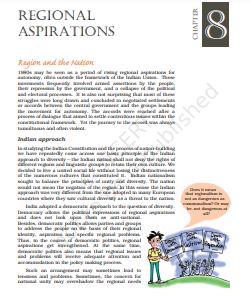‘Regional Aspirations NCERT Solutions for Class 12 Political Science Chapter 8‘ PDF Quick download link is given at the bottom of this article. You can see the PDF demo, size of the PDF, page numbers, and direct download Free PDF of ‘Ncert Class 12 Political Science Chapter 8 Exercise Solution’ using the download button.
NCERT Class 12 Political Science Textbook Chapter 8 With Answer PDF Free Download

Chapter 8: Regional Aspirations
Internally, there is a dispute about the status of Kashmir within the Indian union. You know that Kashmir was given a special status by article 370 in our Constitution.
You have studied the special provisions under articles 370 and 371 last year in the Indian Constitution at Work.
Article 370 gives greater autonomy to Jammu and Kashmir compared to the other States of India. The State has its own Constitution. All provisions of the Indian Constitution are not applicable to the State. Laws passed by the Parliament apply to J&K only if the State agrees.
This special status has provoked two opposite reactions. There is a section of people outside of J&K that believes that the special status of the State conferred by Article 370 does not allow
full integration of the State with India.
This section feels that Article 370 should therefore be revoked and J&K should be like any other State in India. Another section, mostly Kashmiris, believes that the autonomy conferred by Article 370 is not enough.
A section of Kashmiris has expressed at least three major grievances. First, the promise that
Accession would be referred to the people of the State after the situation created by tribal invasion was normalized, has not been fulfilled.
This has generated the demand for a ‘Plebiscite’. Secondly, there is a feeling that the special federal status guaranteed by Article 370, has been eroded in practice.
This has led to the demand for restoration of autonomy or ‘Greater State Autonomy’. Thirdly, it is felt that democracy which is practiced in the rest of India has not been similarly institutionalized in the State of Jammu and Kashmir.
After taking over as the Prime Minister, Sheikh Abdullah initiated major land reforms and other policies which benefited ordinary people.
But there was a growing difference between him and the central government regarding his position on Kashmir’s status.
He was dismissed in 1953 and kept in detention for a number of years.
The leadership that succeeded him did not enjoy as much popular support and was able to rule the State mainly due to the support of the Centre. There were serious allegations of malpractices and rigging in various elections.
During most of the period between 1953 and 1974, the Congress party exercised a lot of influence on the politics of the State.
A truncated National Conference (minus Sheikh Abdullah) remained in power with the active support of Congress for some time but later it merged with the Congress.
| Author | NCERT |
| Language | English |
| No. of Pages | 24 |
| PDF Size | 3.2 MB |
| Category | Political Science |
| Source/Credits | ncert.nic.in |
NCERT Solutions Class 12 Political Science Chapter 8 Regional Aspirations
1. What was the main outcome of the Rajiv Gandhi-Longowal accord in July 1985?
Answer: 1. Chandigarh would be transferred to Punjab.
2. A separate commission to be appointed to resolve the border disputes between Punjab and Haryana.
3. A tribunal to be set up to settle down the sharing of Ravi-Beas river water among Punjab, Haryana, and Rajasthan.
4. To withdraw the Armed forces special power Act in Punjab.
2. What was Goa’s problem? How was Goa liberated and how did it become part of the Indian Union?
Answer. 1. Goa was under Portuguese along with Daman and Diu since the 16th century.
2. We expected freedom in 1947 but Portugal refused to withdraw the people of Goa wanted to merge with the motherland.
3. People of Goa^suppressed from religious conversions and civil rights known as the ‘Goa Problem’.
4. In 1961, within two days Goa, Daman, and Diu were liberated from Portugal’s rule under ‘Operation Vijay’ by the 54Government of India.
5. Goa became part of India and in 1987, it attained the status of ‘State Position’.
3. Describe the outcome of the Anandpur Sahib Resolution of 1973.
Answer: Anandpur Sahib Resolution was passed at the conference of Akali Dal at Anandpur Sahib in 1973:
(a) To ascertain regional autonomy and redefine center-state relations.
(b) Sikhs aspirations aimed at ‘bolbala’ of Sikhs.
(c) It could also be interpreted as a plea for a separate Sikh nation despite federal spirit.
But, it became controversial due to following reasons:
1. Due to the lack of popularity of Akali Dal resolution had a United appeal.
2. Akali government was dismissed in 1980 and it lost its importance.
3. Akali Dal launched a movement on the distribution of water between Punjab, and its neighboring states.
4. Movement went into the hands of extremist elements from moderate
Akalis and converted into an armed insurgency for which Anandpur Sahib Resolution considered responsible.
4. State one similarity and one difference between the crisis in Punjab and Assam during the 1980s.
Answer: Similarity- It was regional aspirations given prior importance and solving the crisis through democratic negotiations.
Differences- In Punjab, Akali Dal started the movement for the formation of ‘Punjabi Sabha’ whereas, in Assam, the crisis was against the people who were seen as outsiders or migrants who were considered to be competitors to employment opportunities.
Regional Aspirations NCERT Textbook With Solutions PDF Free Download
